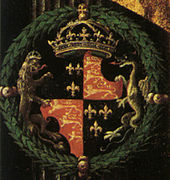Penopang (heraldik)
| Bagian dari seri mengenai |
| Kelengkapan Heraldik |
|---|
| Unsur-Unsur Lambang Kebesaran |
Penopang dalam heraldik adalah gambar makhluk atau benda yang lazimnya ditampilkan pada kedua sisi perisai sehingga tampak seakan-akan sedang menopang perisai.




Bentuk-bentuk penopang tertua didapati pada cap dan meterai peninggalan Abad Pertengahan. Meskipun demikian, tidak seperti mahkota ningrat, ketopong, dan jambul, penopang bukanlah bagian dari heraldik pada Awal Abad Pertengahan. Sebagai bagian dari bawaan lambang kebesaran, penopang pertama kali lazim digunakan menjelang akhir abad ke-15, tetapi bahkan pada abad ke-17 sekalipun penopang belum menjadi salah satu unsur bawaan lambang kebesaran yang dianggap perlu untuk ditampilkan. Sebagai contoh, penopang tidak ditampilkan dalam Siebmachers Wappenbuch (Armorial Siebmachers) tahun 1605.
Gambar penobang dapat diambil dari sosok satwa khayali, manusia, dan sesekali tumbuh-tumbuhan atau benda mati, misalnya gambar pilar-pilar Herkule dalam lambang negara Spanyol. Sebagaimana unsur-unsur heraldik lainnya, penopang seringkali memiliki signifikansi yang bersifat lokal, misalnya gambar nelayan dan penambang timah yang dianugerahkan kepada Dewan County Cornwall, atau memiliki keterkaitan sejarah, misalnya gambar singa dari Inggris dan gambar unikorn dari Skotlandia dalam dua variasi lambang kebesaran Kerajaan Inggris Raya. Lambang kebesaran ahli gizi, John Boyd-Orr, menampilkan gambar dua berkas gandum sebagai penopang, lambang kebesaran USS Donald Cook menampilkan gambar sepasang peluru kendali sebagai penopang, dan lambang kebesaran negara bagian Rio Grande do Norte di Brazil menampilkan gambar dua batang pohon sebagai penopang.[1] Huruf-huruf alfabet digunakan sebagai penopang dalam lambang kebesaran kota Valencia di Spanyol. Gambar manusia sebagai penopang dapat pula berwujud sosok-sosok yang melambangkan gagasan tertentu, atau yang lebih jarang lagi, berwujud orang-orang yang diberi nama tertentu.[2]
There is usually one supporter on each side of the shield, though there are some examples of single supporters placed behind the shield, such as the imperial eagle of the coat of arms of the Holy Roman Empire. The arms of the Congo provide an extremely unusual example of two supporters issuing from behind the shield.[3] While such single supporters are generally eagles[4] with one or two heads, there are other examples, including the cathedra in the case of some Canadian cathedrals.[5] At the other extreme and even rarer, the Scottish chief Dundas of that Ilk had three supporters: two conventional red lions and the whole supported by a salamander. The coat of arms of Iceland even has four supporters.[6]
The context of the application of supporters may vary, although entitlement may be considered conditioned by grant of a type of augmentation of honour by admission in orders of chivalry or by heraldic authorities, such as in the case of traditional British heraldry.
France
In France, writers made a distinctive difference on the subject of supporters, giving the name of Supports to animals, real or imaginary, thus employed; while human figures or angels similarly used are called Tenants (i.e. 'holders'). Trees and other inanimate objects which are sometimes used are called Soutiens.
New Zealand
Knights Grand Companion and Principal Companions of the New Zealand Order of Merit are granted the use of heraldic supporters.[7]
United Kingdom
Originally, in England, supporters were regarded as little more than mere decorative and artistic appendages.
In the United Kingdom, supporters are typically an example of special royal favour, granted at the behest of the sovereign.[8] Hereditary supporters are normally limited to hereditary peers, certain members of the Royal Family, and to some chiefs of Scottish clans. Non-hereditary supporters are granted to life peers, Knights and Ladies of the Order of the Garter and Order of the Thistle, Knights and Dames Grand Cross of the Order of the Bath, Order of St Michael and St George, Royal Victorian Order and Order of the British Empire, and Bailiffs and Dames Grand Cross of the Order of St John. Knights banneret were also granted non-hereditary supporters, but no such knight has been created since the time of Charles I.
Supporters may also be granted to corporations which have a royal charter.-->
Contoh
-
Dua ekor harimau sebagai penopang dalam Jata Negara Malaysia
-
Dua barang pohon sebagai penopang dalam lambang kebesaran Negara Bagian Rio Grande do Norte
-
Sepasang huruf L sebagai penopang dalam lambang kebesaran Kota Valencia
-
Malaikat sebagai penopang tunggal dalam patung lambang kebesaran Polandia di Kraków
-
Dua ekor paus 'terjun' sebagai penopang lambang kebesaran Kotapraja Zaanstad
-
Bendera-bendera sebagai penopang dalam lambang kebesaran Markas Tertinggi Negara-Negara Sekutu Eropa
-
Bendera-bendera dan meriam-meriam sebagai penopang dalam lambang kebesaran Kazimierz Raczyński
-
Sepasang pilar sebagai penopang dalam lambang kebesaran Spanyol
-
Rajawali sebagai penopang tunggal dalam lambang kebesaran Austria
-
Sosok alegori Kebebasan dan Keadilan Buta sebagai penopang dalam Bendera Negara Bagian New York
-
Anjing laut berbulu dan penguin makaroni sebagai penopang dalam lambang kebesaran Wilayah Seberang Laut Georgia Selatan dan Kepulauan Sandwich Selatan
-
Singa Inggris dan unikorn Skotlandia sebagai penopang lambang kebesaran Kerajaan Inggris Raya yang digunakan di Inggris, Wales, dan Irlandia Utara (singa di sebelah kanan-heraldik
-
Lambang kebesaran Kerajaan Inggris Raya yang digunakan di Skotlandia (unikorn di sebelah kanan-heraldik)
Lihat pula
Rujukan
- ^ "Rio Grande do Norte - Brasão de Rio Grande do Norte (coat of arms, crest)". www.ngw.nl. Diakses tanggal 18 March 2018.
- ^ "Flags of the World — Blumenau, Santa Catarina (Brazil)". fotw.net. Diarsipkan dari versi asli tanggal 25 July 2008. Diakses tanggal 18 March 2018.
- ^ "Heraldry of the world - Congo_(Brazzaville)". www.ngw.nl. Diakses tanggal 18 March 2018.
- ^ e.g. Perth & Kinross District Council (Scotland) at Heraldry of the World
- ^ General, The Office of the Secretary to the Governor. "Saint Paul's Cathedral [Civil Institution]". archive.gg.ca. Diakses tanggal 18 March 2018.
- ^ Iceland at Heraldry of the World
- ^ "Statutes of the New Zealand Order of Merit (1996), article 50". legislation.govt.nz. Diakses tanggal 8 December 2016.
- ^ Charles Boutell and Arthur Charles Fox-Davies (2003). English Heraldry. Kessinger. hlm. 238. ISBN 0-7661-4917-X.
